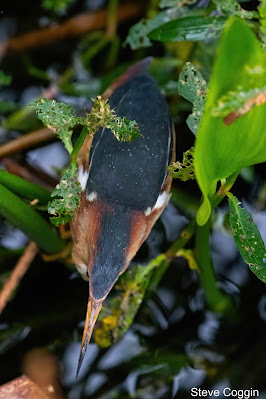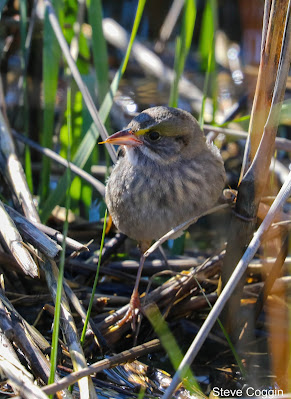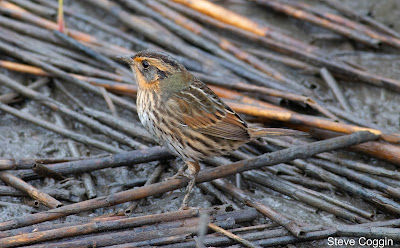 |
| Seaside Sparrow (Ammodramus maritimus). Huntington Beach State Park, South Carolina. |
Some birds are really hard to see. They are camouflaged and blend into their environment, They may live in dense vegetation and only pop out briefly, or they might just be really shy. As difficult as these skulkers are to see, it is even more difficult to get a decent photo. In this post I will share some observations of these skulking birds.
 |
| Brown Creeper (Certhia americana). Rowan County, North Carolina. |
Brown Creepers (Certhia americana) are tiny birds that catch insects on tree trunks. They winter in the Southeastern United States, arriving in October and flying north to breed in the spring. Brown Creepers have a small curved beak, beady little eyes and plumage in many shades of brown with a dappling of white. This pattern makes them disappear into the background of the tree trunk. One cold winter day I plunked a lawn chair down in our front yard and watched a maple tree that a Creeper would sometimes visit. After a cold half hour, a Brown Creeper flew to the bottom of the tree and began spiraling up the trunk. The bird saw me and shyly disappeared around the back of the tree.
 |
| Brown Creeper. Rowan County, North Carolina. |
The Family Caprimulgidae are an interesting group of birds with a bizarre common name. This group is called Goatsuckers or Nightjars and includes Nighthawks as well as other birds. These nocturnal flyers catch insects on the wing, scooping them up in their wide mouths. Those big mouths give them the common name Goatsuckers. An ancient superstition says these birds suck milk from the teats of female goats. This of course does not happen but the tradition lives on in their strange name. While Goatsuckers fly at night, during the day they rest on the ground or tree limbs, perfectly camouflaged with their mottled feathers. Finding one of these birds sleeping is a rare event and involves a great deal of luck. Good luck broke upon us one day in south Texas. Two Common Pauraques (Nyctidromus albicollis) were dozing in a thicket. Our guide pointed to the spot six feet away and said "These will be the closest life birds you will ever have a hard time seeing". We spent a long time staring into the brush before finally seeing the birds.
 |
| Common Pauraque (Nyctidromus ablicollis). Estero Llano Grande State Park, Texas. |
I had a similar experience in Florida. A couple of people with binoculars and cameras were staring into a bush next to trail at the Loxahatchee National Wildlife Refuge. These birders told me a Chuck-will’s-widow (Antrostomus carolinensis) was in there. So cryptic was this skulker I had to strain my eyes for minutes to pick out the bird.
 |
| Chuck-will's-widow (Antrostomus carolinensis). Loxahatchee National Wildlife Refuge, Florida. |
While some wading birds like Great Egrets (Ardea alba) or Roseate Spoonbills (Platalea ajaja) are hard to miss, Bitterns are hard to see. They stand still among the cattails and other marsh plants and blend right in, so it is a treat to get a good look at them. American Bitterns (Botaurus lentiginosus) and Least Bitterns (Ixobrychus exilis) both live in the Southeast for some of the year. We usually get fleeting glimpses of these Bitterns in the marshes of Florida. The American Bittern is the larger of the two and is brown with vertical stripes, mimicking the pattern of the marsh grasses where it hunts fish and other small animals.
 |
| American Bittern (Botaurus lentiginosus) Green Cay Wetlands, Palm Beach County, Florida. |
 |
| American Bittern. Green Cay Wetlands, Palm Beach County, Florida. |
The Least Bittern is half the size of the American Bittern with a short neck and the males have a black crown and back.
 |
| Least Bittern (Ixobrychus exilis). Wakodahatchee Wetlands, Palm Beach County, Florida. |
 |
| Least Bittern. Wakodahatchee Wetlands, Palm Beach County, Florida. |
Saltmarshes along the Atlantic coast host several hard to see sparrows. Seaside Sparrows (Ammodramus maritinmus) live in tidal marshes from New England south to Florida and around the Gulf Coast into Mexico. These sparrows are brown with streaks on the breast, a pointed bill and a yellow spot between the beak and the eye. Their coloration makes them difficult to see unless they perch on the top of the marsh grass. Huntington Beach State Park in South Carolina has extensive saltmarshes and when we visit in fall or winter these sparrows are a special attraction. Sometimes they are only a brown flash above the Spartina (Spartina alterniflora) marsh grass. But sometimes they perch on top of the grass or light on the rocks at the marsh’s edge and give us a really good look.
 |
| Seaside Sparrow. Huntington Beach State Park, South Carolina. |
 |
| Seaside Sparrow. Huntington Beach State Park, South Carolina. |
Saltmarsh Sparrows (Ammondramus caudacutus) have buffy orange on the face with a gray cheek patch and fine stripes on the upper breast. They are found in these same marshes and have much the same behavior as the Seaside Sparrows. Saltmarsh Sparrows feed on grass seeds and with their strict habitat requirement of saltmarshes they are threatened by sea level rise driven by climate change.
 |
| Saltmarsh Sparrow (Ammodramus caudacutus). Huntington Beach State Park, South Carolina. |
 |
| Saltmarsh Sparrow. Huntington Beach State Park, South Carolina. |
I think Rails (Family Rallidae) are the ultimate skulkers. Thirteen species of these chicken-like birds inhabit marshes throughout North America. Rails slip between the marsh plants and it is rare to get a long look. Virginia Rails (Rallus limicola) live in both fresh and salt marshes. They breed in the northern and western United States and southern Canada. Most migrate south for the winter and we ran into a cooperative Virginia Rail at a pond in the Lower Rio Grande Valley of Texas. This Virginia Rail strolled from the cattails for a few seconds and quietly disappeared again.
 |
| Virginia Rail (Rallus limicola). Lake Casa Blanca International State Park, Texas. |
Sora (Porzana carolina) is another species of small rail with a short, yellow bill, black face and barring below. They breed in fresh and brackish marshes in the north and west and migrate south for the winter. Occasionally we run across Soras in the Florida marshes as they creep out of the vegetation and then disappear.
 |
| Sora (Porzana carolina). Green Cay Wetlands, Palm Beach County, Florida. |
Clapper Rails (Rallus crepitans) are larger than Soras and Virginia Rails and are denizens of salt marshes from New England to California and Mexico. Clapper Rails have a long, curved bill, a ruddy breast and barring from the belly to below the tail. Clapper Rails are more often heard than seen. They give a loud kek-kek-kek call that booms across the marsh and resembles clapping. Sometimes Clapper Rails respond with their call to people clapping. Clapper Rails are common in the marshes of Huntington Beach State Park. We hear them calling and if we are lucky, see them walking along the edge of a tidal creek before vanishing into the Spartina marsh.
 |
| Clapper Rail (Rallus crepitans). Huntington Beach State Park, South Carolina. |
All these birds can appear and disappear with surprising ease. They are a real challenge to birders whether they are beginners or old pros. Their cryptic coloration and shy habits allow them to skulk through the world.
 |
| Clapper Rail. Huntington Beach State Park, South Carolina. |








